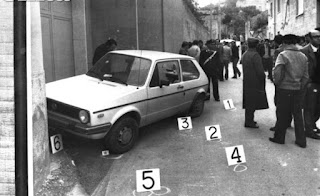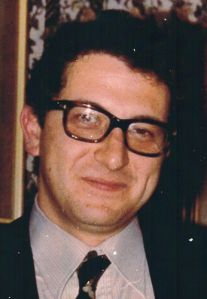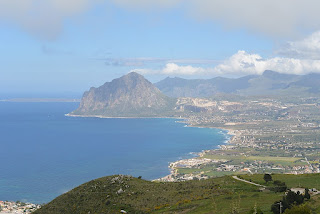Brave investigator murdered by the Sicilian Mafia
 |
| Onlookers gather round Ciaccio Montalto's car the day after the magistrate was killed |
Ciaccio Montalto, a state prosecutor who had been involved in every major organised crime investigation in western Sicily over the previous 12 years, was a short distance from his home in the early hours of the morning when his Volkswagen Golf was forced off the road.
Three men armed with machine guns and pistols opened fire, hitting Ciaccio Montalto multiple times, leaving his bullet-ridden body slumped in the driver’s seat. Used to hearing gunshots, none of the nearby residents ventured out to see what had happened and it was not until 7.15am that a passing carabinieri patrol came across the car and discovered the magistrate’s body. He was 41 years old.
The VW’s clock, which police believed stopped working because of the damage to the car, was showing 1.12am, which suggested that Ciaccio Montalto had been dead for just over six hours.
Ciaccio Montalto was an Italian magistrate who was a public prosecutor in Trapani, known for his investigations into the Mafia’s involvement in drug trafficking and their links to the local business and banking community and politicians.
 |
| Ciaccio Montalto was a formidable adversary of the Trapani Mafia |
Speculation linked his killing either to an investigation in 1982 that led to arrest warrants being issued for 40 Mafia members and businessmen in the Trapani area, or to the arrest of two leading politicians - a regional Liberal party secretary and a noted member of the Republican party - on charges of granting illegal building contracts to Mafia figures.
His death did not have the same impact as the slaying of Giovanni Falcone and Paolo Borsellino almost a decade later, but was nonetheless a severe blow for the fight against the Mafia in Sicily, robbing the judiciary of a courageous and dedicated magistrate.
It was the Mafia's second major strike against the Italian state in just a few months following the killing of the carabinieri chief General Carlo Alberto Dalla Chiesa and his wife in Palermo the previous September.
Ciaccio Montalto was born into a family of legal professionals. His father, Enrico, was a judge in the Court of Cassation, and his grandfather, Giacomo Montalto, a notary and former mayor of Erice, an historic hill town in Trapani province. Giangiacomo’s younger brother, Enrico, was a political activist who died in a car accident at the age of 22.
Although he was born in Milan, Ciaccio Montalto soon dedicated himself to the fight against crime in the city of his roots. He returned to Sicily in 1971, a year after beginning his legal career in the north, and rapidly rose to the level of Deputy Prosecutor of the Republic of Trapani.
Among the high-profile investigations he led was one into the so-called “Marsala monster” that ended with Michele Vinci, who was convicted of kidnapping three girls, including his niece, and leaving them to die in a well, being sentenced to 28 years in jail.
 |
| Ciaccio Montalto was due to be transferred to Florence |
And thanks to Ciaccio Montalto’s work, the Minore brothers, a Mafia clan who controlled Trapani from the 1950s to the late ‘70s and were heavily involved in drug dealing and arms trafficking, as well as being suspected of carrying out many murders, were effectively driven out of the area, brothers Antonino - known as ‘Totò’ - Calogero, Giuseppe and Giacomo being forced to live as fugitives after the magistrate issued an arrest warrant for Totò Minore in 1979 for weapons trafficking.
Ciaccio Montalto was realistic enough to know his success would put his own safety under threat. Soon after the 40 Mafia members and entrepreneurs he ordered to be arrested in 1982 were released due to lack of evidence, a black cross was painted on the bonnet of the car in which he would ultimately be killed. Unlike some high-profile investigators in the long fight against the Cosa Nostra, he did not have the security of an armour-plated vehicle or a police escort.
Disappointed with the result of that investigation and others, Ciaccio Montalto asked for a transfer to Florence, hoping to investigate the activities of an enclave of Trapani mafiosi who had settled there. The request was granted, but he was killed before it could happen.
Initial investigations into Ciaccio Montalto’s death pointed towards the Minore clan. Salvatore Minore, in fact, was sentenced to life imprisonment in absentia for ordering the killing and two mafiosi for carrying it out, although all three were later acquitted by an appeal court. It was later discovered that Minore himself had been killed a year before Ciaccio Montalto.
Ultimately, on the basis of evidence provided by new witnesses and Mafia informers, the killing was attributed to the notorious Corleonesi mobster Salvatore ‘Totò’ Riina, who was seen as the capo di tutti capi - boss of all bosses - on Sicily, along with another leading mob figure, Mariano Agate. Riina, by then already in jail serving several life sentences, was handed another, along with Agate. Two corrupt lawyers, one of whom tipped off Riina after learning of Ciaccio Montalto’s intention to tackle the Trapani gangs in Florence, were acquitted on the grounds of unreliable testimony.
Ciaccio Montalto was granted a state funeral, conducted by the bishop of Trapani, Monsignor Emanuele Romano, at the cathedral of San Lorenzo, where 20,000 people gathered outside.
He was survived by his wife, Marisa La Torre, who would later be appointed deputy mayor of Trapani, and their three daughters Maria Irene, Elena and Silvia.
 |
| The territory of Valderice includes mountain scenary and a sweep of coastline |
The small town of Valderice, where Giangiacomo Ciaccio Montalto lived and sadly died while investigating crimes in Trapani province, has gone under that name only since 1958. It was previously known as Paparella but was renamed following the division of the Monte San Giuliano municipal area. Valderice, which is 8km (five miles) northeast of Trapani and about 95km (60 miles) west of Palermo, includes several scenic areas such as the stunning Zingaro Nature Reserve with its 7km of wild cliff top walks and the remains of a stone age settlement, and three beach areas: Bonagia, Lido Valderice and Rio Forgia. In the town, the churches of Santa Maria della Misericordia, built in 1637, and Sant’Andrea Apostolo are among the oldest in the area. The Molino Excelsior is an old mill now converted to the Centro di Cultura Gastronomica, which every year provides gastronomic events, workshops and lessons to promote local customs and traditions.
.jpg) |
| Erice is one of Sicily's most beautiful towns with an abundance of picturesque narrow streets |
Dating back 3,000 years, Erice is one of Sicily’s most beautiful towns, a mediaeval gem that nestles some 2,464 feet above the sea, surrounded by vineyards in the mountains behind Trapani. It is a fortified town with charming, narrow streets, echoing with history and blessed with a pace of life from a different age. Erice is watched over by an impressive 12th-13th century Norman castle, the Castello di Venere, where visitors can stroll around the grassy interior courtyard, flanked by an impressive stone wall allegedly built by Daedalus, the architect of Greek mythology. The castle offers spectacular panoramic views. Erice has many churches and chapels, including the Norman-style church of San Martino, the church of Sant’Albertino degli Abbati and Chiesa Madre, dedicated to Santa Maria Assunta, with its quadrangular bell tower. One of the most attractive parts of Erice is the Spanish quarter, said to have been built in the period of Spanish domination to house Spanish soldiers, a requirement for every Sicilian city.
Also on this day:
1755: The birth of physician Paolo Mascagni
1852: The birth of explorer Pierre Savorgnan de Brazza
1866: The birth of operatic baritone Antonio Scotti
1982: The birth of singer-songwriter Noemi


































